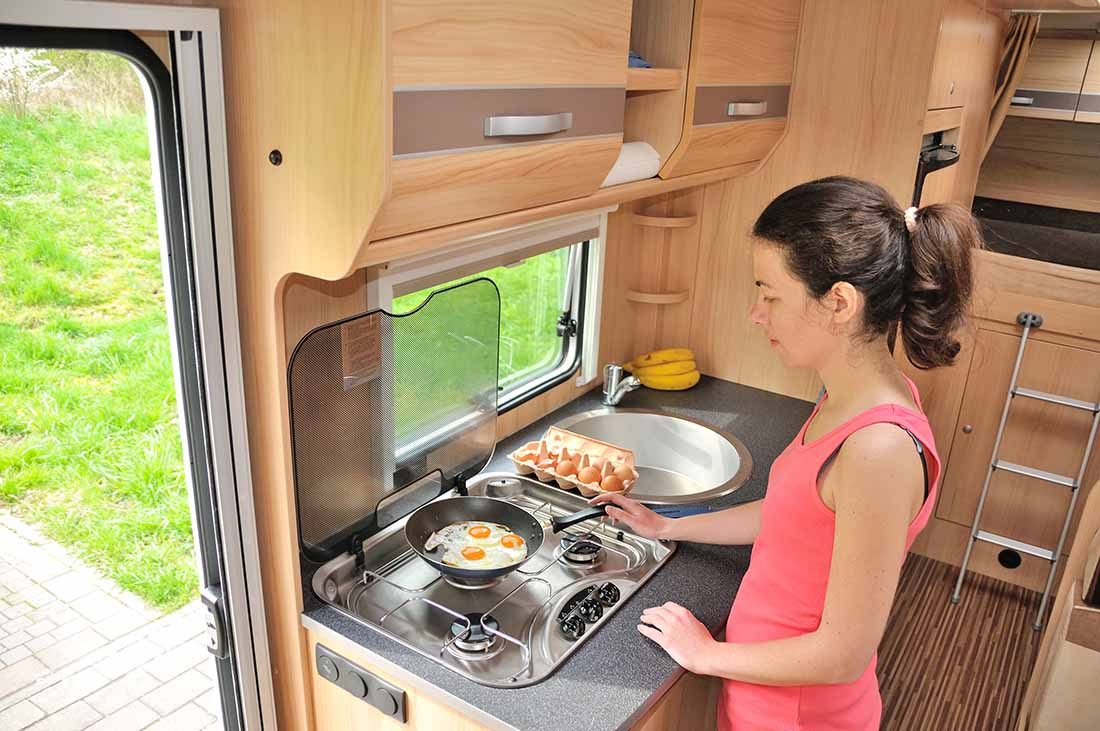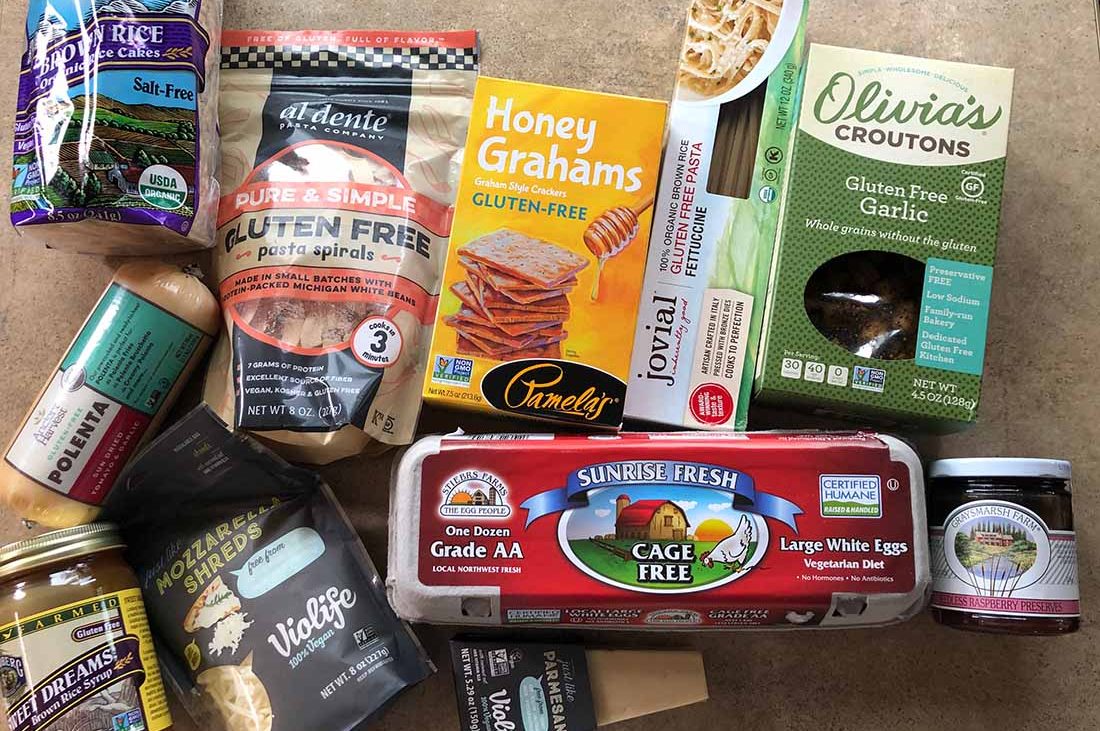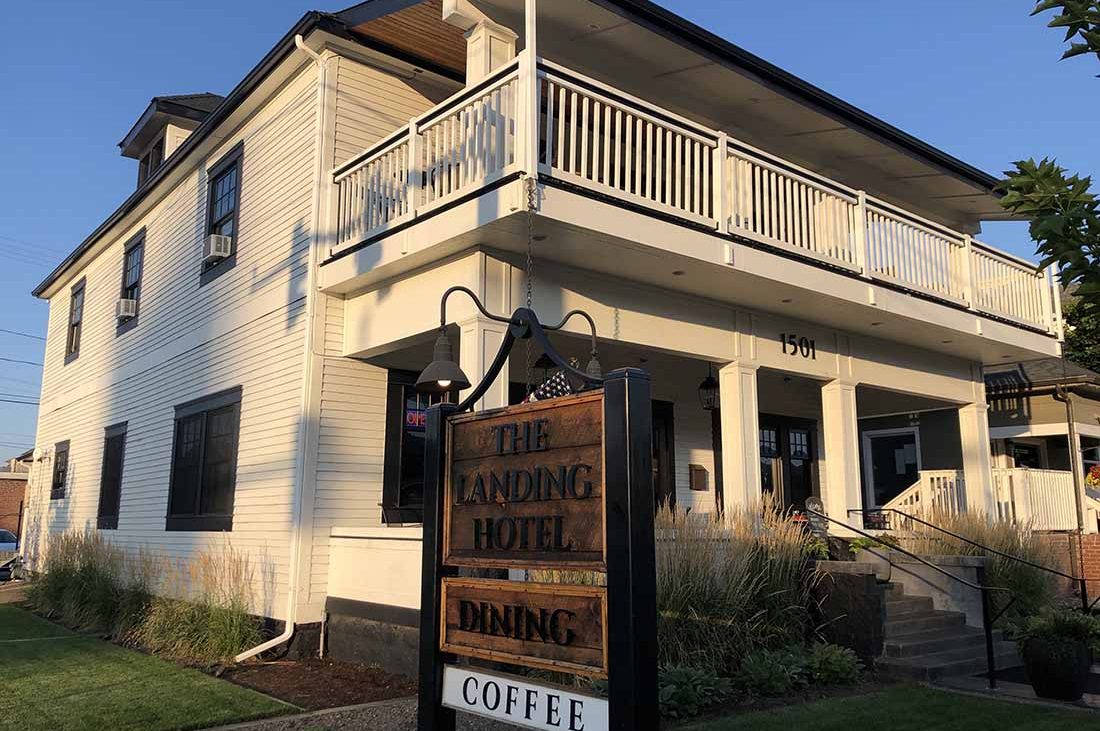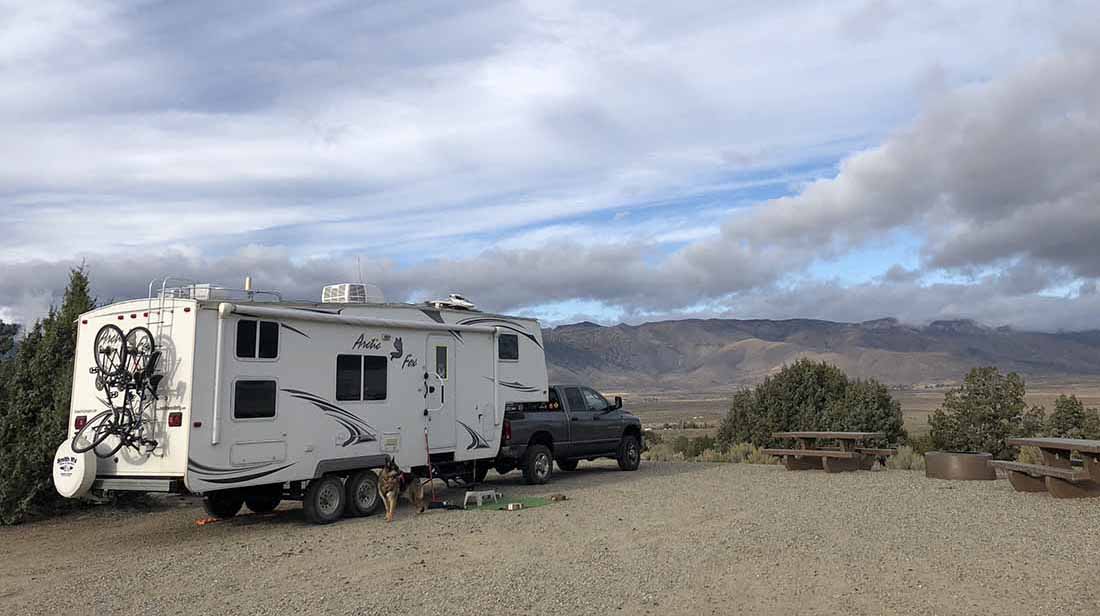RVing with diet restrictions.
There’s one in every group. The person who can’t eat this or that, the one who doesn’t want to eat at a certain restaurant when everyone else does. I never thought I would be one of those people, but apparently, now I am. And suddenly, I’m RVing with food sensitivities is on my mind wherever we roam. Here’s how I’m able to live with it.

Family vacation, RV holiday trip, travel and camping, happy smiling woman cooking in camper, motorhome interior
What I’ve Learned About RVing with Restricted Diets
RVing got trickier when a medical situation alerted me to my gluten intolerance. My doctor said that if I wanted to feel better — which I do — then it was time to give up the gluten. But that’s not all. Other off-limit foods include soy, most dairy, caffeine and chocolate. It’s part of a year-long food sensitivity test that hasn’t been fun for me or my husband. As vegetarians, these foods constitute a huge part of our diet. But I’m doing the test and my husband is willingly going along with the changes. Thankfully, as full-time RVers, we travel with our home and kitchen, which makes coping with the new restricted diet a bit tricky and sometimes even adventurous.
Here’s how we’re coping:
Roadblocks and Workarounds
First, it’s important to know that RVing with restricted diets turns any shopping trip into a project. Unless I’m buying produce, meat or fish, it takes about twice as long as it used to for me to shop. Now, I must scan the ingredient list of every packaged food I select. Whether fresh, frozen or dehydrated, keeping my eyes peeled for forbidden foods adds time and money to any grocery run. When we travel to new places, it adds an extra layer of complexity. For example:
Stocking up on packaged favorites is essential. Whether you’re a full-time RVer like me or a weekend traveler, it pays to visit your favorite grocery store and pack the RV pantry full of your favorite non-perishables. Who wants to waste time searching for these foods when you could be out having fun instead? I sure don’t. Stocking up also pays off because the same grocery store chain doesn’t always carry my favorite items in different towns. Before we move on to a new location, I shop for essentials and use an app called Gluten-Free Scanner to check for hidden gluten ingredients in unfamiliar packaged foods.

An array of gluten-free food is available on the market. Photo: Rene Agredano
Our fridge is crammed with fruits and veggies. We are eating more produce than ever, but unfortunately, the size of our Norcold RV refrigerator makes it challenging to stock more than five days worth of eats. Here’s how we try:
- To save space, I find that pre-washed and cut fruits and vegetables packaged in square and rectangular containers work best.
- I can extend the freshness of non-packaged fruits and veggies with special produce bags lined with natural coatings to slow down spoilage. The “Green Bags” brand is fantastic.
- If I had space I would invest in a high-quality portable cooler. It would give me more storage and if my food allergies were life-threatening, it’s also the best way to reduce the risk of cross-contact in a tiny RV kitchen.

The Landing Hotel in LaGrande, Oregon, serves up some gluten-free items on its menu. Photo: Rene Agredano
What About Traveling With Mixed-food Households?
Taking your kitchen on the road is a blessing for RVers on restricted diets. But if you’re traveling with a partner or family who isn’t food sensitive and who doesn’t want to eliminate your off-limit foods from their diet, that’s when things get tricky. You may want to try these suggestions for RVing with others who don’t share your dietary preferences:
- Designate gluten-free zones. Carve out storage space in your cabinets, refrigerator shelves and, most importantly, on the kitchen countertops for meal prep.
- Store your own set of utensils, kitchen towels and sponges separately. And unless you want to carry two toasters in the RV, purchase reusable “toaster bags” that allow you to toast bread in your existing toaster. This may take some organization, but it’s worth it.
- Prohibit all baking. Inhaling a few specs of gluten can cause problems for many people. So if your partner won’t try recipes with gluten-free flours, then nobody should bake, period.
- Keep foods tightly covered in the convection oven. The circulating air can cross-contaminate your food.
Have Fun Exploring New Restaurants Along the Way
When I began eating a restricted diet, we thought our dining out days were done. What a joy to find out plenty of options in our travels. Health-conscious eateries are popping up in some of America’s most exciting RV destinations. For example, we recently went to the Wynn Hotel Buffet in Las Vegas, where the head chef gave us a personal tour of the buffet line to point out menu items I could enjoy. He even offered to have his staff prepare many of the items in a separate kitchen. The food was fantastic, and it was the one of the best dining experiences of our lives.
I also discovered two amazing gluten-free bakeries in Las Vegas. Staff was so helpful and even educated me about their ingredients. Best of all, these gluten-free sweet treats were among the best we’ve tried. Now I’m learning there are plenty of options for dining out, as long as I do the research. Here’s how:
-

Two scoops of gluten-free ice cream at the Wynn Las Vegas. Photo: Rene Agredano
Use gluten-free guides. As of today, two of the best are and Allergy Eats. Both allow you to search on your computer or their smartphone app. Keep in mind that these guides are based on user reviews, and don’t guarantee that the restaurant can accommodate your dining needs.
- If possible, call your restaurant ahead of time. Choose off-hours to speak with staff who can recommend appropriate items.
- Ask questions when ordering. If the waitstaff can’t verify the ingredients of menu items, ask to meet the chef before ordering.
- Speak up when visiting friends and family. There’s no need to put your health in jeopardy just because relatives or friends are in charge of the kitchen. Even if they say you don’t need to bring anything, let them know you will make a dish for your get-together. At least you’ll guarantee that you won’t go home hungry.
Since my life was turned upside down with a restricted diet, I’ve discovered yet another benefit of RVing. Because I can take my own kind of foods along wherever we travel, exploring new places is more interesting than ever. Unlike being on a train, plane or ship, a home on wheels can take the frustration and guesswork out of traveling with a restricted-diet lifestyle. I hope you don’t ever need to eat the way I do, but if so, at least you’ll know that RVing can introduce you to new stores and restaurants that enhance your travels.





